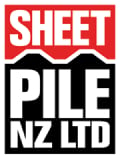Taking a little extra time to handle sheet pile properly will save you a lot in damage costs at the other end. Be sure to read the following tips to prevent excessive wear and tear and damage to sheet piles before beginning your driving operation.
Did you know?
Damage mainly occurs in two areas: 1. The handling of the sheet – from rough or inaccurate handling – and 2. Excessive force applied to the sheet when it is out of alignment or encountering hard soils.
Different degrees of damage
Damage varies from excessive wear and tear, where a sheet can be reused, through to extreme damage, where sheets can only be scrapped.
Before you start
Inspect sheets prior to installation, making sure to check the clutches are clear of debris/soil and free of damage. Sheets that have either of these issues will require more and/or excessive force to install.
During handling
Be careful when lifting bundles and individual sheets. Use the lifting eye to lift a sheet where possible. If using the ‘handling teeth’ on a side-grip piler to extract and stand a sheet from a bundle, ensure the operator is competent to do so and the jaws clamp cleanly on a flat area of the sheet, well clear of the clutches or corners on the sheet.
Four areas to watch out for where excessive force could be used:
- Damaged sheets: Do not use these sheets. Set them aside and use undamaged sheets.
- Hard soil or a hard layer in the soil: Check with experienced operators and engineers if the type of sheet you are going to use can withstand the required force to penetrate the soil. Use a stronger sheet that can be installed in these soils. Use a crane-mounted vibro-head with more force. Use water or air jetting at the toe of the sheet to aid penetration.
- Excavator-mounted vibro-heads: With these, the operator can push down on the sheet, especially where side-grip vibro-heads are used. Tearing and splitting of the sheet can occur as the side-grip jaws twist and slip on the sheet when excessive force down is applied. The operator here is normally inexperienced or being forced to get the sheets installed to an unrealistic depth. The site manager/engineer on occasions will need to get a crane-mounted vibro-head with more force.
- Forcing a sheet when out of alignment: Use a guide frame/template system to hold a sheet in alignment while installation occurs. This takes extra time to set up, however, it will save time and extra costs for damaged sheets later. Where a sheet starts to go out of alignment, stop, partially extract the sheet, realign it, then continue to install the sheet. Never continue to install the sheet when out of alignment unless the site manager/engineer approves for you to continue, knowing the sheet will likely be damaged and may not be in a condition to be re-used.
Always…
- Budget for a percentage loss when pricing a job
- Use competent, experienced operators
- Use the appropriate sheet, method and vibro-head for the depth and soil type the sheet is going into
